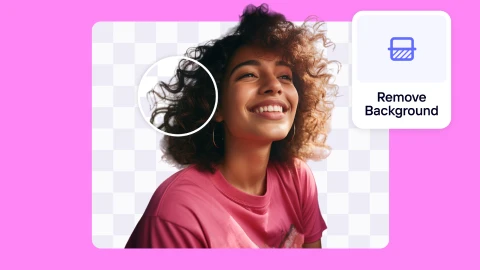Visual AI in e-commerce: Applications, benefits, and future trends
From elevated product images to hyper-personalized shopping experiences to virtual try-ons, visual artificial intelligence (visual AI) is transforming how products are showcased and sold online, resulting in boosted customer engagement and sales.
Whether you're an experienced entrepreneur or new to online selling, understanding and implementing it could be the difference between leading the pack or trailing behind.
In this article, you’ll learn what visual AI is, how it works, applications, benefits, and future predictions for this growing market.
Table of contents
What is visual artificial intelligence and how does it work?
Advantages of visual artificial intelligence in product photography
What is visual artificial intelligence and how does it work?
Visual AI works by combining various technologies like machine learning, computer vision, natural language processing (NLP), and deep learning to teach computers to see and understand pictures so they can recognize elements in images or videos, much like a human would.
Through the analysis of vast amounts of visual data, AI algorithms learn to identify patterns, shapes, and colors, enabling them to categorize objects, detect anomalies, or even predict future outcomes based on visual inputs.
At Photoroom, we’re building a foundation AI model called Photoroom Instant Diffusion (Photoroom ID) that we’re training from scratch. It’s built around user needs so you can quickly, easily, and safely generate the images you need for both business and personal use.
Learn more about our recent product updates including new AI tools that generate images from text prompts, curved text, higher-quality AI backgrounds, and more.
“We’re starting with AI Backgrounds to have the highest quality and fastest background generators for users”, says Matthieu Rouif, co-founder and CEO at Photoroom. “But once we have the model trained, it will offer up other opportunities too.”

“Our foundation model is tailor-made for product photography and for what we know works for our users in the app and for the creative workflow that we pioneered, which is very different from a lot of the other big guys out there,” says Ben Lefaudeux, head of machine learning at Photoroom.
At Photoroom, we take a human-centered AI approach, our foundation AI model is built around user needs.
“We never build a model just for the sake of it, or for research,” says Matthieu. “We always try to connect what we’re building to the needs coming from our millions of users.”
Visual AI is a growing market
According to Statista, the visual AI or computer vision market is projected to reach $26.26 billion in 2024 and it’s expected to show an annual growth rate of 11.69% from 2024 to 2030, resulting in a market volume of $50.97 billion by 2030. It’s predicted that the largest market size will be in the United States, at $9.45 billion in 2024.

We also have proof that visual AI is a growing market that’s benefiting online sellers.

Five billion images were generated last year using Photoroom’s AI photo editing tools.
Most Photoroom users double online sales thanks to high-quality, professional product photography.
150 million people have downloaded the Photoroom app since launching in 2019.
“Photoroom helps me with my six figure online business and also helped me launch my social media platforms,” says Amazon seller, Owen Lloyd. “Sales were absolutely awful before Photoroom. On a good day, I’d sell three bottles of perfume. Now, a normal day is at least 50 bottles, that’s around 16 times more sales than before. Photoroom can take credit for my increase in sales.”
Visual AI applications in e-commerce and retail
Visual AI has various applications in a range of industries, including e-commerce, healthcare, education, consumer electronics, and more. However, this article focuses mainly on how it transforms customer experiences, operational efficiency, and sales in e-commerce and retail.
From AI photo editing tools like Photoroom to AI-powered product recommendations and virtual try-ons via Google Shopping, visual artificial intelligence can improve customer shopping experiences and help you increase sales.
Here are some examples of these applications:
1. Photoroom
At Photoroom, we use visual AI to help you quickly edit and enhance product photography for your website, marketing assets, and ad campaigns to improve customer experiences and boost sales.
A few key core features that online sellers love are:
AI Backgrounds. Erase image backgrounds in a few seconds and replace them with an existing Photoroom template or your AI-generated creation.
Retouch. Clean up images and remove any object, person, or watermark in three seconds.
AI Images Generator. Generate images from text for marketing assets, website banners, or inspiration. (Beta)
AI Shadows. Add realistic, studio-quality shadows instantly to your product images.
Bulk Resize and Image Editing. Efficiently adjust and edit batches of images to meet various social media and sales channel requirements.
“I don’t need Photoshop anymore,” says Nenad Radonjanin, e-commerce manager at Feydom. “I used to do things manually, but now it’s much faster when I can edit many different images at speed. And I can do everything on my phone.”
In a recent test to see how Photoroom-generated images can boost ad results, we delivered a +34% improvement.

Potential customers prefer to see products in a contextual setting.
The power of high-quality imagery can’t be understated.
The value of data-driven decision-making.
Photoroom’s foundation model prioritizes safety, speed, and flexibility
We’re building our own foundation model to ensure you always have a safe, fast, and flexible experience. Our co-founder and CTO, Eliot Andres, explains how we’re doing this.
Safety
“The model will not be able to generate violent or sexually explicit imagery,” says Eliot. “We have full control, so the model will never see any image with violence or nudity, making it impossible to generate any images like this.”
Speed
“It has been key for Photoroom to have very fast image generation,” says Eliot. “Having custom architecture allows us to really juice the power of the GPUs (graphics processing units) that we're using. That combined with our years of expertise optimizing models is how we make sure we’re getting the best performance out of this technology.”
Flexibility
“We went for a custom architecture to get flexibility on what we could achieve,” says Eliot. “Our model is very niche—we have features that no other model has because we specialize in product photography.”
Further reading: 16+ Best AI tools for e-commerce: Boost productivity, creativity, and sales
2. Syte

Hibbett, an athletic-inspired omnichannel fashion retailer with an online presence and more than 1000 physical stores across the US, successfully eliminated out-of-stock roadblocks with Syte's similar recommendations feature. The brand saw an increase in conversion rates and average order value (AOV).

3. Google Shopping's AI virtual try-on feature
In June 2023, Google’s AI virtual try-on feature made it possible for US shoppers to virtually try on women’s tops from brands across Google, including Anthropologie, Everlane, H&M, and LOFT. In November 2023, it expanded to men’s tops.


Advantages of visual artificial intelligence in product photography
1. Wider access to high-quality images
Tools like Photoroom, for example, make it easier to create professional product images for selling online without any photography, editing, or graphic design experience.
“The goal is to give small actors the means to operate at the level of the big guns—we’re here to level the playing field,” says Eliot.
2. Better customer experiences
High-quality product images showing various angles provide a better shopping experience, boosting engagement and sales.
3. Improved efficiency
With the right visual AI tools, you can streamline operations and creativity, leaving more time to spend on strategic decisions to help grow your business.
“We have people saying Photoroom changed my life because they were struggling with image quality,” says Eliot.
“Not everyone has access to top photographers, a large studio, and people who can organize a shoot. And even if they do, it takes months sometimes to organize. The ability to take your phone out of your pocket, and instantly shoot your product, is mind-blowing for users.”
4. Increased sales
High-quality visuals generated by AI tools like Photoroom can boost product appeal and conversion rates.
5. Reduced costs
Using an AI photo editing app like Photoroom means you don’t have to hire a photographer and rent studio space to create high-quality product images, saving you time and money.
“We are a family-owned business,” says Andrew Cattarin, e-commerce manager at The Gamesmen. “Photoroom allows us to do more with our small team and scale. With AI tools coming into play, it helps our niche—we don’t have money to burn or to hire tons of staff to get work done. We have 15,000 products to list online which would normally be a monstrous manual task that takes weeks and weeks.”
Implement visual AI in your business with Photoroom

Assess your needs. Identify areas in your business where visual AI can have the most impact, such as studio-quality photography for product pages, lifestyle images for social media, or marketing assets for email campaigns.
Choose the right Photoroom plan. We have a range of AI tools that are free for everyone, and affordable for businesses. Photoroom Pro, Our most popular paid-for subscription, Photoroom Pro, costs $4.99 a week/$89.99 a year. It comes with visual generative AI photo editing features including AI Backgrounds, AI Shadows, batch editing, 1,000+ design templates, and collaborative features for teams, as well as optimizing and resizing images for a range of platforms.
Gather your visuals. Collect the images you want to enhance or take new product photos as you need them for your website or marketing channels.
Upload to Photoroom. Use the Photoroom Web or mobile app (iPhone or Android) to upload your visuals and enhance them in minutes. Use batch mode to edit dozens of images at once.
Customize according to your needs. Find templates that are the perfect size for popular social media platforms and sales channels like Instagram, Facebook, Shopify, and Etsy, to name a few.
Analyze and adapt. Review your website and social media analytics to see how your AI-enhanced visuals performed. Learn what images resulted in the most engagement and sales so you can leverage those strategies.
PRO TIP: Check out Photoroom’s API to integrate visual GenAI technology with your e-commerce website so you can easily edit and enhance product images.
Future predictions for visual AI in e-commerce and retail
The future of visual AI holds promising advancements that will further transform e-commerce and retail.
Enhanced automation
Advancements in AI photo editing automation will handle complex processes like adjusting light conditions, skin retouching, and object removal automatically.
“Photoroom already does this,” says Matt. “But it will become more automated so you can edit photos based on personal preferences.”
Visual AI assistants
AI assistants who know your needs will provide real-time photo editing feedback and suggestions.
“AI that knows your Instagram or shop will automatically apply the styles to your photo editing,” says Matt. “Or you’ll be able to train it with content from another brand that you like, a mood board you create in the app, or your past photo collections.”
VR and AR integrations
AI’s integration with virtual reality (VR) and augmented reality (AR) will blend physical and digital worlds. Editors may eventually be able to enter a virtual space to edit and interact with their photos in three dimensions.
Photo restoration
AI-powered photo restoration and enhancement tools will make it possible to remove stains, correct faded colors, and remove tears in historical photographs.
“Today you can increase the resolution,” says Matt. “But it lacks context. In the future, you’ll be able to give it another photo of a person and it will be restored accurately.”
Reducing bias
Bias mitigation remains a priority for companies. They will continue using diverse data sets for AI training to avoid biases. Efforts to create AI detection tools to address deepfakes and identify manipulated content will continue.
Adopt visual AI tools or risk falling behind
Adopting visual AI tools is no longer a luxury—it's a necessity for staying competitive. Using visual artificial intelligence in your e-commerce business can not only enhance the quality of your product and marketing images but also significantly boost customer engagement and sales.
Leveraging AI through services like Photoroom can be a game-changer in how you present, market, and sell products online. So take action now to experience all the benefits of visual AI and avoid falling behind.
Start today by integrating Photoroom into your creative processes to improve product photography workflows and boost sales. Download the free app now (Web, iPhone, or Android) to enhance your product images using visual AI tools to remove and replace backgrounds, eliminate unwanted objects, create high-quality studio photos, and more.





Design your next great image
Whether you're selling, promoting, or posting, bring your idea to life with a design that stands out.
















